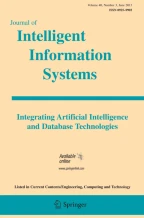Abstract
Trends such as the massive increase in information available via electronic networks, the use of on-line product data by distributed concurrent engineering teams, and dynamic supply chain integration for electronic commerce are placing severe burdens on traditional methods of information sharing and retrieval. Sources of information are far too numerous and dynamic to be found via traditional information retrieval methods, and potential consumers are seeing increased need for automatic notification services. Matchmaking is an approach based on emerging information integration technologies whereby potential producers and consumers of information send messages describing their information capabilities and needs. These descriptions, represented in rich, machine-interpretable description languages, are unified by the matchmaker to identify potential matches. Based on the matches, a variety of information brokering services are performed. We introduce matchmaking, and argue that it permits large numbers of dynamic consumers and providers, operating on rapidly-changing data, to share information more effectively than via traditional methods. Two matchmakers are described, the SHADE matchmaker, which operates over logic-based and structured text languages, and the COINS matchmaker, which operates over free text. These matchmakers have been used for a variety of applications, most significantly, in the domains of engieeering and electronic commerce. We describe our experiences with the SHADE and COINS matchmaker, and we outline the major observed benefits and problems of matchmaking.
Similar content being viewed by others
Explore related subjects
Discover the latest articles, news and stories from top researchers in related subjects.References
Arens, Y., C.Y. Chee, C.N. Hsu, and C. Knoblock. Retrieving and integrating data from multiple information sources. International Journal of Intelligent and Cooperative Information Systems, 2(2), 1993.
Advanced Research Projects Agency. Reference architecture for the intelligent integration of information. Prepared by the Program on Intelligent Integration of Information, Richard Hull and Roger King, eds., 1995.
Chawathe, S., H. Garcia-Molina, J. Hammer, K. Ireland, Y. Papakonstantinou, J. Ullman, and J. Widom. The TSIMMIS project: Integration of heterogeneous information sources. In Proceedings of IPSJ Conference, Tokyo, Japan, 1994.
Davis, M., R. Evans, G. Davis, and G. Jones. Simulation based design for submarines. In Proceedings of the Submarine Technology Symposium, JHU/APL, 1993.
Finin, T., J. Weber, G. Wiederhold, M. Genesereth, R. Fritzson, D. McKay, J. McGuire, R. Pelavin, S. Shapiro, and C. Beck. Draft specification of the KQML agent-communication language. Technical report, The ARPA Knowledge Sharing Initiative External Interfaces Working Group, 1993.
Genesereth, M. An agent-based framework for software interoperability. In Proceedings DARPA Software Technology Conference, 1992.
Genesereth, M. and R. Fikes. Knowledge Interchange Format, version 3.0 reference manual. Technical Report Logic-92-1, Computer Science Department, Stanford University, 1992.
Gruber, T. A translation approach to portable ontology specifications. Knowledge Acquisition, 5(2), 1993.
Kuokka, D. and L. Harada. A communication infrastructure for concurrent engineering. Journal of Artificial Intelligence in Engineering, Design, Analysis, and Manufacturing, 1995.
Kuokka, D. and B., Livezey. A collaborative parametric design agent. In Proceedings of the National Conference on Artificial Intelligence, pages 387–393, Menlo Park, CA, 1994 AAAI Press.
Kuokka, D. The Deliberative Integration of Planning, Execution, and Learning. PhD thesis, School of Computer Science, Carnegie Mellon University, 1990.
Kuokka, D. An evolution of collaborative design tools. In AAAI-94 Workshop on Models of Conflict Management in Cooperative Problem Solving. AAAI Tech. Report WS-94-04, 1994.
Mark, W. and J. Dukes-Schlossberg. Cosmos: A system for supporting engineering negotiation. Concurrent Engineering: Research and Applications, 2(3), 1994.
McGuire, J., D. Kuokka, J. Weber, J. Tenenbaum, T. Gruber, and G. Olsen. SHADE: Technology for knowledge-based collaborative engineering. Concurrent Engineering: Research and Applications, 1(3), 1993.
Mauldin, M. and J. Leavitt. Web-agent related research at the CMT. In Proceedings of the ACM Special Interest Group on Notworked Information Discovery and Retrieval (SIGNIDR-94), 1994.
Patil, R.,R. Fikes, P. Patel-Schneider, D. McKay, T. Finin, T. Gruber, and R. Neches. The DARPA Knowledge Sharing Effort: Progress report. In Proceedings of the Third International Conference on Principles of Knowledge Representation and Reasoning. Morgan Kaufmann, 1992.
Salton, G. Automatic Text Processing—The Analysis, Transformation and Retrieval of Information by Computer. Addison-Wesley, Reading, MA, 1989.
Singh, N. A CommonLisp API and facilitator for ABSI (revision 2.0.3). Technical Report Logic-93-4, Stanford University Computer Science Department Logic Group, 1993.
Wiederhold, G. Mediators in the architecture of future information systems. IEEE Computer, 25(3), 1992.
Author information
Authors and Affiliations
Rights and permissions
About this article
Cite this article
Kuokka, D., Harada, L. Integrating information via matchmaking. J Intell Inf Syst 6, 261–279 (1996). https://doi.org/10.1007/BF00122130
Issue Date:
DOI: https://doi.org/10.1007/BF00122130
